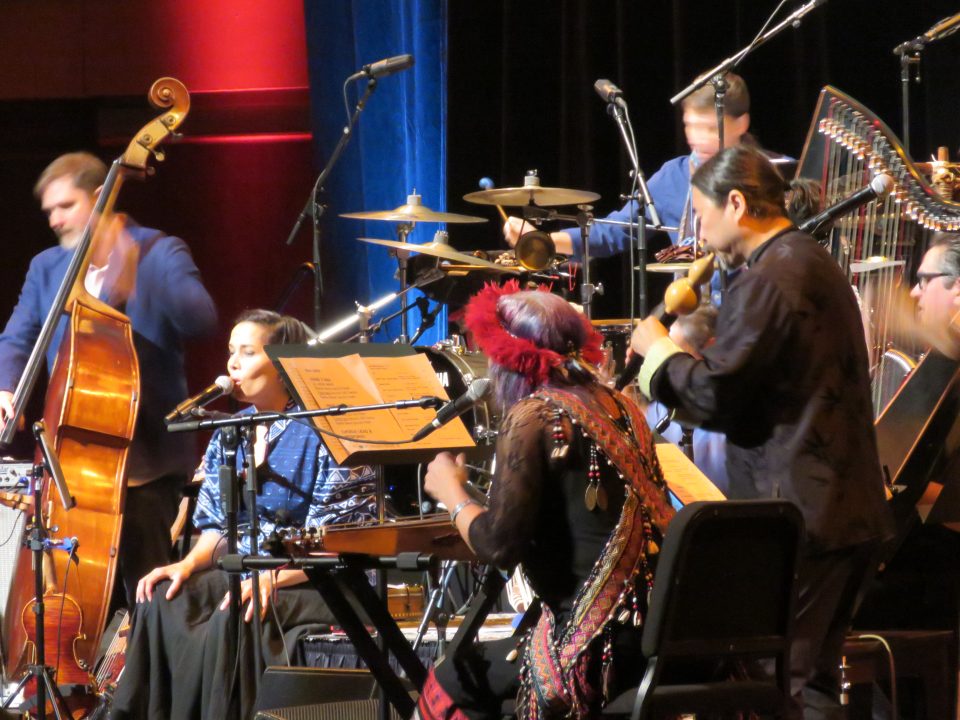By Jim Bloch
You knew something wondrous was about to happen as Rhiannon Giddens led her 13-piece world-music band, the Silkroad Ensemble, onto the big stage at Hill Auditorium in Ann Arbor to perform songs from their new work “American Railroad.”
The instruments alone promised a peak night, a mix of the familiar and the less common. Giddens’ banjo and fiddle, Mike Block’s cello, Layale Chaker’s violin, Edward Perez’s upright and electric basses, Mario Gotoh’s viola and Maeve Gilchrist’s Celtic harp represented the familiar. On the stranger side: Balla
Kouyaté’s balafon, an African hardwood xylophone; Francesco Turrisi’s big frame drum; Kaoru Watanabe’s Japanese flute and percussion instruments; Sandeep Das’ tabla, the paired hand drums of India famous for their sharp, liquid sounds; Yazhi Guo’s suona, a ancient Chinese double-reed horn; and Pura Fe’s lap steel guitar.

It was three days after the election that returned Donald Trump to the White House along with his apocalyptic anti-immigrant fantasies about dark-skinned murderers and rapists taking over American towns and eating the pets of white people.
This was the opposite: A celebration – and a socio-cultural excavation — of the roles played by exploited immigrants and uprooted American Indians in the building of the Transcontinental Railroad, nearly 2,000 mile of train tracks that linked the West coast of the U.S. to the Eastern network of rail lines that ended in Omaha. After six years of hard construction during and after the Civil War, Leland Stanford, president of the Central Pacific Railroad Company of California, pounded in the golden spike linking east to west in 1869. Only white men appeared in the famous photo of the event.
“I was always interested in those who weren’t in that photo,” said Giddens, who directs the ensemble. “There was this thing that connected the coasts. But at what cost?”

Rhiannon Giddens in Ann Arbor.
Silkroad Ensemble’s “American Railroad” musically explores the roles of four main “pillars” of people in the building of the railroad: African Americans, Irish and Chinese workers plus the Indigenous communities, who worked on the railroad, but who more generally had their lands confiscated by the U.S. government and assembled as the rights-of-way for the railroads. There were others: Italians, Mexicans, Polish and other eastern European people, and the Japanese who filled jobs held by Chinese after the Exclusion Act.
The band gave voices to the exploited laborers drowned out by the chorus of historical cheers for the audacity of the engineering feat, the economic expansion that followed in the wake of the railroad and the nation-building consequences of linking New York and San Francisco.
Work gangs of immigrants and outsiders expanded and maintained the rail system, which grew from 10,000 miles in 1850 to 215,000 miles in 1900.
“Progress demanded hard labor that was filthy, dangerous, disease-ridden, unfair, degrading and underpaid,” said Ryan Dearinger, a historian at George Fox University, in an essay about the railway. “They were exposed to cycles of blistering hot and bone-chilling cold weather as they toiled in knee-deep muck, braved water-borne illnesses, chipped away at solid granite and endured hard rock blasts and cave-ins.”
The band told the stories of the immigrants who built the railroad through music “that resembles work songs that allowed teams to work in unison to sustain the long, physically arduous and backbreaking work …,” said Anna Eng, a scholar of Chinese American Studies at U.C.-Berkeley and San Francisco State, in an essay about the project. “Music that would have reminded laborers of home and soothed them of their longings.”
More than 10,000 Chinese men worked on the California portion of the new railroad, carving rail beds through the Sierra Nevada Mountains. Their reward was a number of state laws that trimmed their rights, followed by the Chinese Exclusion Act passed by Congress in 1882. It prohibited the immigration of Chinese workers in the US for a decade and was the first national law excluding a specific race of people from coming to America. It stayed in force until 1943.
Each of the band members contributed songs that honored workers who could have been their ancestors. Yazhi Guo, for example, contributed “Pink Butteflies Picking Flowers,” a traditional song from Southern China, an area that saw the first Chinese immigrants venturing abroad. The song is both uplifting and ironic.
“The composition is lively, characterized by a vibrant, playful melody that captures the imagery of a butterfly fluttering among flowers, collecting pollen and evoking a sense of light hearted joy,” said Guo in the program notes.
The band itself was named for the 4,000 mile long Silk Road, an interconnected network of trade routes that linked southern Europe and East Africa with Asia, resulting new economic and cultural interactions and confrontations between the people who traveled, bartered and lived along the road between the second century BCE and the mid 1400s.
The Silkroad Ensemble was formed by cellist Yo-Yo Ma in 1998 and included musicians from various countries along the route. Ma’s goal? “A new musical language founded in difference, a metaphor for the benefits of a more connected world,” according to the program.
The Transcontinental Railroad was America’s version of Silk Road, but a harder, meaner one, at once more exploitative and more technologically aggressive.
“In American Railroad, we found a story that allowed us to shed light on those who have been erased or overlooked throughout mainstream American history,” said Giddens, who will be an artist-in-residence at the University of Michigan in 2025-26.
The album “American Railroad” will be released Nov. 15.
Jim Bloch is a freelance writer based in St. Clair, Michigan. Contact him at bloch.jim@gmail.com.



